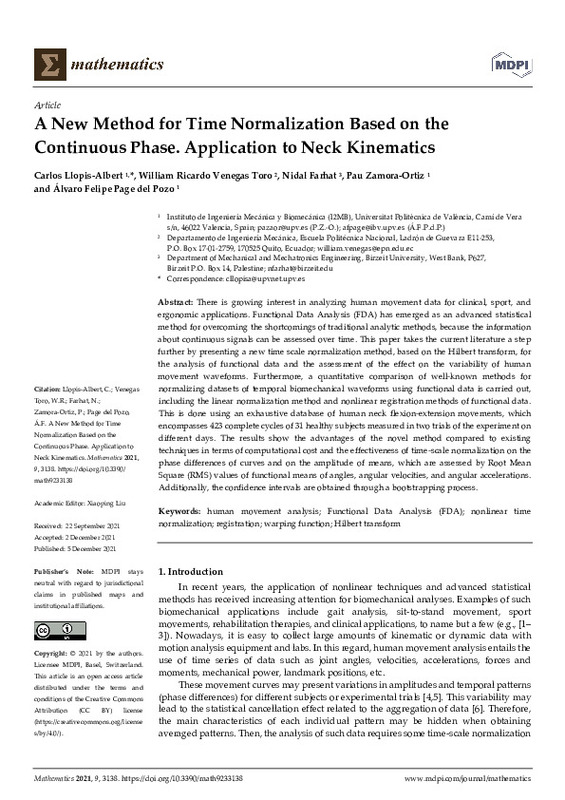JavaScript is disabled for your browser. Some features of this site may not work without it.
Buscar en RiuNet
Listar
Mi cuenta
Estadísticas
Ayuda RiuNet
Admin. UPV
A New Method for Time Normalization Based on the Continuous Phase. Application to Neck Kinematics
Mostrar el registro sencillo del ítem
Ficheros en el ítem
| dc.contributor.author | Llopis-Albert, Carlos
|
es_ES |
| dc.contributor.author | Venegas-Toro, William Ricardo
|
es_ES |
| dc.contributor.author | Farhat, Nidal
|
es_ES |
| dc.contributor.author | Zamora-Ortiz, Pau
|
es_ES |
| dc.contributor.author | Page Del Pozo, Alvaro Felipe
|
es_ES |
| dc.date.accessioned | 2022-09-22T18:03:17Z | |
| dc.date.available | 2022-09-22T18:03:17Z | |
| dc.date.issued | 2021-12 | es_ES |
| dc.identifier.uri | http://hdl.handle.net/10251/186467 | |
| dc.description.abstract | [EN] There is growing interest in analyzing human movement data for clinical, sport, and ergonomic applications. Functional Data Analysis (FDA) has emerged as an advanced statistical method for overcoming the shortcomings of traditional analytic methods, because the information about continuous signals can be assessed over time. This paper takes the current literature a step further by presenting a new time scale normalization method, based on the Hilbert transform, for the analysis of functional data and the assessment of the effect on the variability of human movement waveforms. Furthermore, a quantitative comparison of well-known methods for normalizing datasets of temporal biomechanical waveforms using functional data is carried out, including the linear normalization method and nonlinear registration methods of functional data. This is done using an exhaustive database of human neck flexion-extension movements, which encompasses 423 complete cycles of 31 healthy subjects measured in two trials of the experiment on different days. The results show the advantages of the novel method compared to existing techniques in terms of computational cost and the effectiveness of time-scale normalization on the phase differences of curves and on the amplitude of means, which are assessed by Root Mean Square (RMS) values of functional means of angles, angular velocities, and angular accelerations. Additionally, the confidence intervals are obtained through a bootstrapping process. | es_ES |
| dc.description.sponsorship | This research was funded by the Spanish Government and co-financed by EU FEDER funds (Grant DPI2017-84201-R) and by Escuela Politecnica Nacional de Quito (Grant PIJ-1508). | |
| dc.language | Inglés | es_ES |
| dc.publisher | MDPI AG | es_ES |
| dc.relation.ispartof | Mathematics | es_ES |
| dc.rights | Reconocimiento (by) | es_ES |
| dc.subject | Human movement analysis | es_ES |
| dc.subject | Functional Data Analysis (FDA) | es_ES |
| dc.subject | Nonlinear time normalization | es_ES |
| dc.subject | Registration | es_ES |
| dc.subject | Warping function | es_ES |
| dc.subject | Hilbert transform | es_ES |
| dc.subject.classification | FISICA APLICADA | es_ES |
| dc.subject.classification | INGENIERIA MECANICA | es_ES |
| dc.title | A New Method for Time Normalization Based on the Continuous Phase. Application to Neck Kinematics | es_ES |
| dc.type | Artículo | es_ES |
| dc.identifier.doi | 10.3390/math9233138 | es_ES |
| dc.relation.projectID | info:eu-repo/grantAgreement/AEI/Plan Estatal de Investigación Científica y Técnica y de Innovación 2013-2016/DPI2017-84201-R/ES/INTEGRACION DE MODELOS BIOMECANICOS EN EL DESARROLLO Y OPERACION DE ROBOTS REHABILITADORES RECONFIGURABLES/ | es_ES |
| dc.relation.projectID | info:eu-repo/grantAgreement/EPN//PIJ-1508/ | es_ES |
| dc.rights.accessRights | Abierto | es_ES |
| dc.contributor.affiliation | Universitat Politècnica de València. Departamento de Ingeniería Mecánica y de Materiales - Departament d'Enginyeria Mecànica i de Materials | es_ES |
| dc.contributor.affiliation | Universitat Politècnica de València. Departamento de Física Aplicada - Departament de Física Aplicada | es_ES |
| dc.description.bibliographicCitation | Llopis-Albert, C.; Venegas-Toro, WR.; Farhat, N.; Zamora-Ortiz, P.; Page Del Pozo, AF. (2021). A New Method for Time Normalization Based on the Continuous Phase. Application to Neck Kinematics. Mathematics. 9(23):1-16. https://doi.org/10.3390/math9233138 | es_ES |
| dc.description.accrualMethod | S | es_ES |
| dc.relation.publisherversion | https://doi.org/10.3390/math9233138 | es_ES |
| dc.description.upvformatpinicio | 1 | es_ES |
| dc.description.upvformatpfin | 16 | es_ES |
| dc.type.version | info:eu-repo/semantics/publishedVersion | es_ES |
| dc.description.volume | 9 | es_ES |
| dc.description.issue | 23 | es_ES |
| dc.identifier.eissn | 2227-7390 | es_ES |
| dc.relation.pasarela | S\451498 | es_ES |
| dc.contributor.funder | Agencia Estatal de Investigación | es_ES |
| dc.contributor.funder | European Regional Development Fund | es_ES |
| dc.contributor.funder | Escuela Politécnica Nacional, Ecuador | es_ES |








